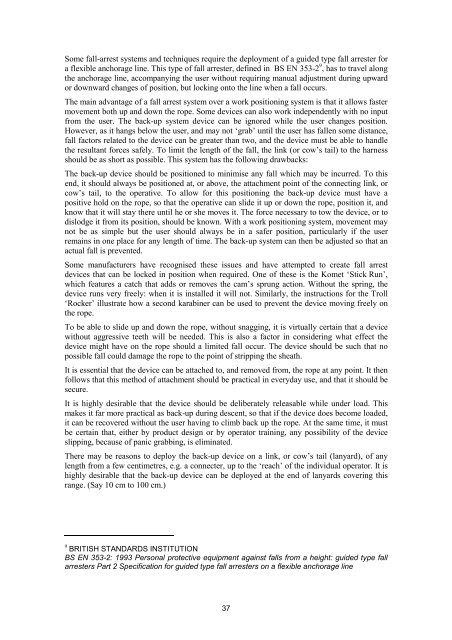HSE: Industrial rope access - investigation into items of personal ...
HSE: Industrial rope access - investigation into items of personal ...
HSE: Industrial rope access - investigation into items of personal ...
Create successful ePaper yourself
Turn your PDF publications into a flip-book with our unique Google optimized e-Paper software.
Some fall-arrest systems and techniques require the deployment <strong>of</strong> a guided type fall arrester for<br />
a flexible anchorage line. This type <strong>of</strong> fall arrester, defined in BS EN 353-2 9 , has to travel along<br />
the anchorage line, accompanying the user without requiring manual adjustment during upward<br />
or downward changes <strong>of</strong> position, but locking onto the line when a fall occurs.<br />
The main advantage <strong>of</strong> a fall arrest system over a work positioning system is that it allows faster<br />
movement both up and down the <strong>rope</strong>. Some devices can also work independently with no input<br />
from the user. The back-up system device can be ignored while the user changes position.<br />
However, as it hangs below the user, and may not ‘grab’ until the user has fallen some distance,<br />
fall factors related to the device can be greater than two, and the device must be able to handle<br />
the resultant forces safely. To limit the length <strong>of</strong> the fall, the link (or cow’s tail) to the harness<br />
should be as short as possible. This system has the following drawbacks:<br />
The back-up device should be positioned to minimise any fall which may be incurred. To this<br />
end, it should always be positioned at, or above, the attachment point <strong>of</strong> the connecting link, or<br />
cow’s tail, to the operative. To allow for this positioning the back-up device must have a<br />
positive hold on the <strong>rope</strong>, so that the operative can slide it up or down the <strong>rope</strong>, position it, and<br />
know that it will stay there until he or she moves it. The force necessary to tow the device, or to<br />
dislodge it from its position, should be known. With a work positioning system, movement may<br />
not be as simple but the user should always be in a safer position, particularly if the user<br />
remains in one place for any length <strong>of</strong> time. The back-up system can then be adjusted so that an<br />
actual fall is prevented.<br />
Some manufacturers have recognised these issues and have attempted to create fall arrest<br />
devices that can be locked in position when required. One <strong>of</strong> these is the Komet ‘Stick Run’,<br />
which features a catch that adds or removes the cam’s sprung action. Without the spring, the<br />
device runs very freely: when it is installed it will not. Similarly, the instructions for the Troll<br />
‘Rocker’ illustrate how a second karabiner can be used to prevent the device moving freely on<br />
the <strong>rope</strong>.<br />
To be able to slide up and down the <strong>rope</strong>, without snagging, it is virtually certain that a device<br />
without aggressive teeth will be needed. This is also a factor in considering what effect the<br />
device might have on the <strong>rope</strong> should a limited fall occur. The device should be such that no<br />
possible fall could damage the <strong>rope</strong> to the point <strong>of</strong> stripping the sheath.<br />
It is essential that the device can be attached to, and removed from, the <strong>rope</strong> at any point. It then<br />
follows that this method <strong>of</strong> attachment should be practical in everyday use, and that it should be<br />
secure.<br />
It is highly desirable that the device should be deliberately releasable while under load. This<br />
makes it far more practical as back-up during descent, so that if the device does become loaded,<br />
it can be recovered without the user having to climb back up the <strong>rope</strong>. At the same time, it must<br />
be certain that, either by product design or by operator training, any possibility <strong>of</strong> the device<br />
slipping, because <strong>of</strong> panic grabbing, is eliminated.<br />
There may be reasons to deploy the back-up device on a link, or cow’s tail (lanyard), <strong>of</strong> any<br />
length from a few centimetres, e.g. a connecter, up to the ‘reach’ <strong>of</strong> the individual operator. It is<br />
highly desirable that the back-up device can be deployed at the end <strong>of</strong> lanyards covering this<br />
range. (Say 10 cm to 100 cm.)<br />
9 BRITISH STANDARDS INSTITUTION<br />
BS EN 353-2: 1993 Personal protective equipment against falls from a height: guided type fall<br />
arresters Part 2 Specification for guided type fall arresters on a flexible anchorage line<br />
37

















